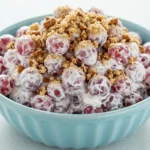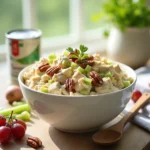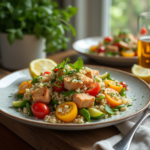introduction
I remember the day I first tried a homemade bundt cake. My grandmother was a skilled baker, and she approached each recipe with a calm focus that made everyone around her feel at ease. I was still young and curious, peering over her shoulder as she spooned flour into the mixing bowl. The aroma of butter and sugar filled the warm kitchen. She carefully poured the batter into a well-greased bundt pan, explaining how its circular shape gave the cake a golden crust.
A few hours later, we cut into the finished dessert. The texture was moist, dense, and packed with flavor. It was unlike any other cake I had tried before. The ring shape made it feel both elegant and homey, perfect for casual gatherings and special occasions.
That day, I discovered my love for bundt cakes. I found a certain joy in their simplicity and their stunning design. Over the years, I have tested various flavors—from classic vanilla to chocolate swirls and fresh lemon drizzles. Each version retains that signature ring and ensures a delightful crumb.
Over time, I refined techniques, learning that room temperature ingredients and a hand yield magic.
Now, I want to share the same feeling of warmth and enjoyment with you. This story is not just about the cake but also the memories it stirs. When I bake a bundt cake, I remember laughter in the kitchen, the scent of vanilla in the air, and the sweet satisfaction of slicing into something truly special
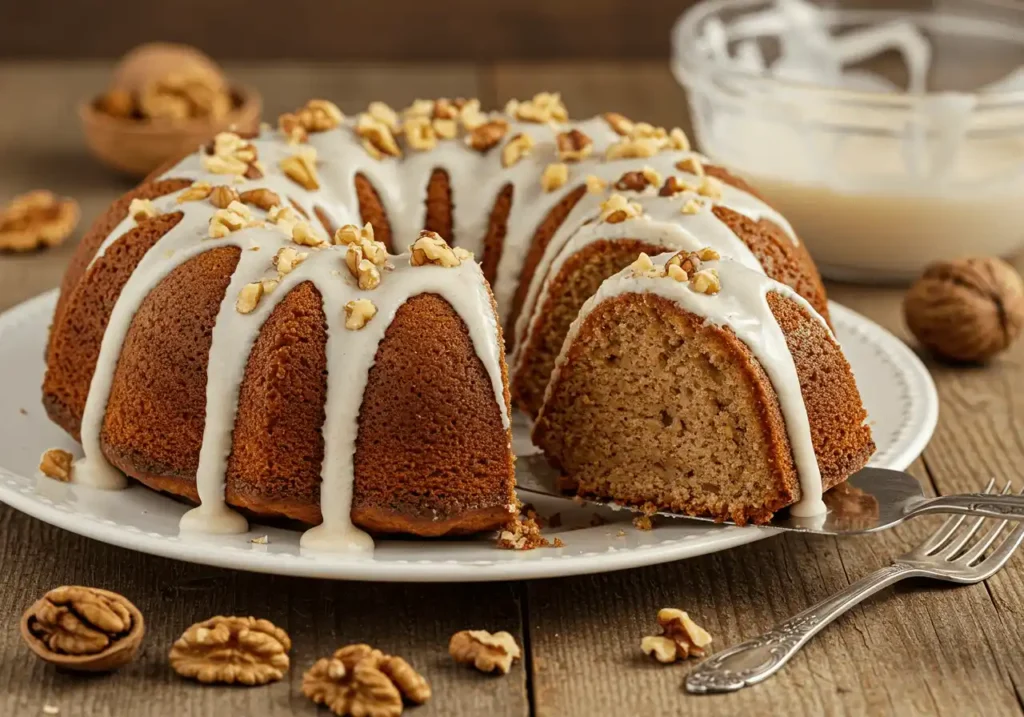
Table of Contents
Key Benefits
A bundt cake stands out for its striking shape and unique baking advantages. The ring design promotes even heat distribution, helping create a golden-brown exterior while keeping the interior moist. This contrast between a crisp outer layer and a soft crumb is one reason people prize a bundt cake for special events and everyday treats.
Another advantage is the ease of decorating. Once you remove the cake from the bundt pan, you often have a lovely pattern on the surface. A simple dusting of powdered sugar or a light glaze can transform the cake’s appearance. You do not need elaborate frosting techniques, so it saves time while still looking impressive on a dessert table.
The texture is a key selling point. Many recipes call for creamy ingredients like sour cream, which adds richness and a soft bite. In addition, room temperature eggs and butter blend smoothly, giving the batter an even consistency. This process helps lock in flavor, guaranteeing a dense but tender crumb.
Bundt cakes also offer flexibility for experimentation. You can use a classic vanilla recipe, try fresh fruit flavors, or go for a swirl of chocolate. Each version retains the basic shape and convenience of a single-layer cake, so there is no stacking or complicated assembly required. In short, the bundt cake is simple enough for beginners yet striking enough for seasoned bakers who want a reliable dessert with minimal fuss.
Ingredients
When preparing a bundt cake, a balanced mix of dry and wet ingredients helps create a light, tender crumb that also holds its shape. Here are the core elements you will need before you begin:
- Flour: Many bundt cake recipes use all-purpose flour, but some call for cake flour for a finer texture.
- Sugar: Granulated sugar is standard for sweetness. A touch of brown sugar can add depth to certain variations, such as a coffee cake style or a chocolate bundt cake.
- Leavening Agents: Baking powder and sometimes baking soda help the batter rise, leading to a soft interior.
- Fat Component: Butter is a common choice, bringing richness. Make sure it is at room temperature to blend smoothly.
- Eggs: Eggs also need to be at room temperature to incorporate seamlessly and support structure.
- Liquid or Creamy Additions: Sour cream or heavy whipping cream improves moisture. Some recipes include buttermilk for a tangy twist or fresh lemon juice for a lemon bundt cake variation.
- Flavoring: A high-quality vanilla extract or a vanilla bean is crucial for a vanilla bundt cake. You can also add citrus zests or chocolate chips if you want other flavors.
- Salt: This basic ingredient amplifies sweet and savory notes.
- Sweet Toppings: Powdered sugar is perfect for dusting, while a simple vanilla glaze or a cream cheese drizzle can make the cake even more appealing.
Keep these items handy, and remember to gather them in one spot. Having each ingredient at the right temperature and measuring with care ensures the batter comes together without lumps, guaranteeing the moist result we look for in a perfect bundt cake.
Instructions
Follow these steps to create a classic bundt cake that delivers a moist crumb every time. You can adapt these guidelines to make a lemon bundt cake, a chocolate bundt cake, or even mini bundt cakes later on.
- Preheat Your Oven
Set your oven to 350°F (175°C). A proper preheat ensures that your batter begins baking right away, helping the cake rise evenly.
- Grease and Flour the Pan
Generously coat a 12-cup bundt pan (or a 10-cup bundt pan, if specified by the recipe) with butter or shortening. Coat the pan with flour, then gently shake off any extra. This step stops the cake from sticking and makes it easier to remove the cake from the pan once baked.
- Combine Dry Ingredients
In a large bowl, whisk together your flour (or cake flour), baking powder, and salt. This ensures each is evenly distributed, so the cake has a consistent texture.
- Cream Butter and Sugar
In a separate mixing bowl, beat room temperature butter with granulated sugar until light and fluffy. This process creates small air pockets, making the best bundt cake tender. Scrape down the sides of the bowl to keep the mixture even.
- Add Eggs One at a Time
Crack eggs into a small dish before adding them to the butter-sugar blend, mixing well after each addition. This technique keeps the batter smooth and helps incorporate each egg fully.
- Incorporate Key Flavors
Pour in vanilla extract (or add fresh vanilla bean seeds for extra vanilla flavor). Add the sour cream next, beating on low speed until combined. This ingredient helps produce a moist cake and balances sweetness.
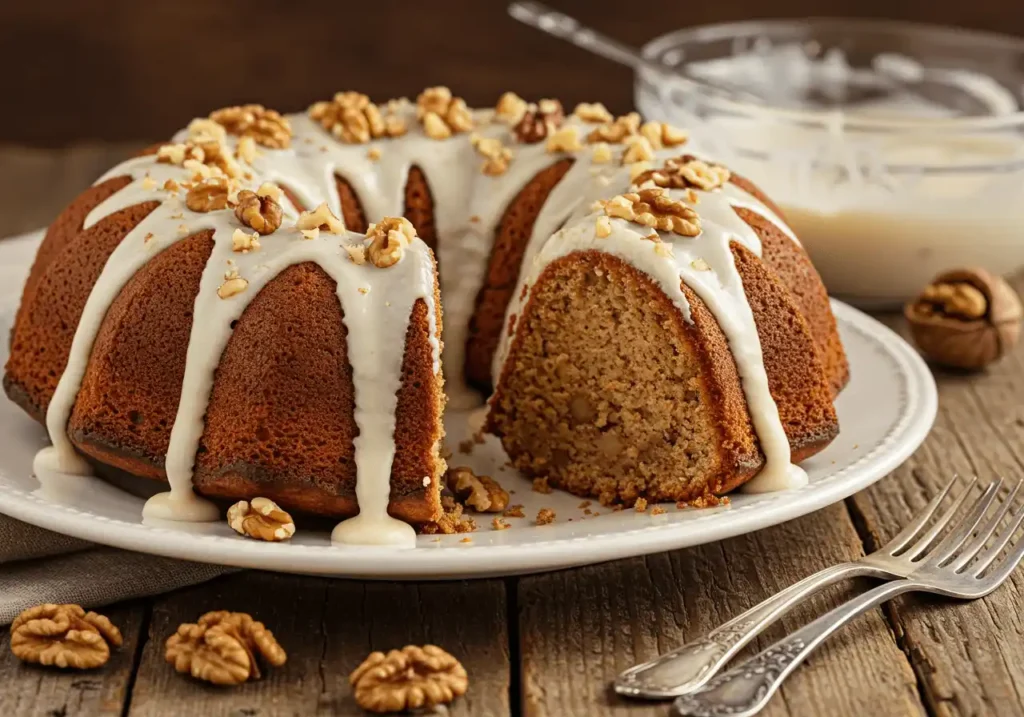
- Alternate Wet and Dry
Keep the mixer running at a low speed as you gradually add a portion of the dry ingredients. Follow with a splash of milk or heavy whipping cream (if the recipe calls for it). Repeat, alternating until you have a unified batter. Avoid overmixing to keep the crumb tender.
- Pour the Cake Batter
Transfer your cake batter into the prepared bundt pan and smooth the top using a spatula. Lightly bump the pan against the counter to loosen any hidden air pockets.
- Bake the Cake
Slide the pan into the oven and bake for 45–55 minutes, depending on your oven’s heat distribution. You will know the cake is done when a toothpick inserted into the thickest part of the cake comes out clean or with moist crumbs attached.
- Allow the Cake to Cool
Once it’s fully baked, take the cake out and place it on a cooling rack for about 10–15 minutes. This short wait makes the cake more stable and easier to flip. If you rush, you risk breaking the cake.
- Flip the Cake
Carefully remove the cake from the cake pan. Put a plate or cooling rack on top of the pan, then turn it upside down. Gently lift the pan away to reveal the ridges and pattern of your bundt cake.
- Final Touches
Let the cake cool completely before adding any finish. Many people like to dust it with powdered sugar, frost it with cream cheese frosting, or drizzle a simple vanilla glaze. Each topping highlights the ring shape and adds extra sweetness.
Follow these steps, and you will have a flavorful cake with a soft interior and an attractive golden surface. If you prefer alternative flavors—such as a pound cake style, a coffee cake twist, or a lemon cake spiked with fresh lemon juice—the same method applies. You can even adapt a regular cake mix for a quick version, though bake this cake from scratch at least once to appreciate the full richness of a homemade bundt cake.
Pro Tips and Variations
Creating the best bundt cake goes beyond following a recipe card. Simple adjustments and unique flavor spins help you master a delicious cake with minimal guesswork:
- Preparation and Pan Choice
Grease a bundt cake pan thoroughly, whether it’s a 12-cup bundt pan or a smaller size. Some bakers swear by a metal option like a nordic ware bundt, as it heats evenly. If you need to scale down, you can try mini bundt cakes for single servings.
- Get Ingredients Ready
Pull out butter, eggs, and sour cream early so they reach room temperature. This step makes the batter smoother and helps the cake rise evenly. Also, verify that your baking powder has not expired; freshness improves lift and texture.
- Add the Sour Cream for Moisture
Whether you are making a classic bundt cake, a lemon bundt cake, or a chocolate bundt cake, a scoop of cup sour cream locks in richness. It also highlights other flavors such as vanilla extract, cocoa, or fresh lemon juice.
- Experiment with Flavors
- Classic Vanilla Bundt Cake Recipe: Use cake flour, a vanilla bean, and a simple vanilla glaze. This approach can also be turned into a vanilla cake variation by swapping half of the sugar for brown sugar for added warmth.
- Chocolate Twist: Swap part of the flour for cocoa powder, or follow your favorite chocolate cake recipe if you want a fully chocolate bundt cake.
- Lemon Kick: Stir in fresh lemon juice and zest for a bright lemon cake spin, or even craft a lemon loaf cake style in a bundt shape.
- Classic Vanilla Bundt Cake Recipe: Use cake flour, a vanilla bean, and a simple vanilla glaze. This approach can also be turned into a vanilla cake variation by swapping half of the sugar for brown sugar for added warmth.
- Test for Doneness
A toothpick in the thickest part of the cake should emerge with moist crumbs. If the center is still wet, continue baking in short intervals until the cake comes out clean.
- Finishing Touches
Allow the cake to cool in the pan for several minutes, then invert it onto a rack. Once you remove the cake, drizzle it with cream cheese icing, dust it with powdered sugar, or simply enjoy it plain. Any of these options can turn a normal gathering into something special.
- Adapting Cake Mix
If you want to make this cake quickly, you can use a regular cake mix in your bundt cake pan. Just keep an eye on the baking time to ensure the cake is done and emerges with a tender crumb.
These tips help you explore everything from a pound cake approach to a coffee cake flair or even a yellow cake adaptation. When you bake this cake, feel free to get creative with add-ins and toppings. The ring shape remains the star, and the end result is a homemade bundt cake that wows guests every single time.
Serving Suggestions
A bundt cake is versatile enough to serve in many ways. If you are aiming for a quick and refined look, dust the cooled cake with powdered sugar. This highlights the ridges of the pan’s design, giving a classy finish without much effort. For something sweeter, drizzle a simple vanilla glaze or a tangy lemon icing. That extra layer of flavor complements a moist interior and creates a pretty sheen on top.
You can also take a more decadent route. Try a cream cheese drizzle combined with fresh berries, or blend heavy cream and chocolate chips for a glossy ganache. Such toppings pair well with a classic vanilla bundt cake recipe, a chocolate bundt cake, or even a citrus-based cake like a lemon bundt cake. Another quick fix: warm some jam or fruit preserves in the microwave until pourable, then spoon it over individual slices.
If you want to make the cake feel festive, pair it with a scoop of ice cream or whipped cream. You can also garnish with toasted nuts, coconut flakes, or chocolate shavings. For brunch gatherings, slice the cake alongside a fresh fruit salad, coffee, and tea. This approach works nicely for a coffee cake variation or any bundt that has a light, buttery crumb.
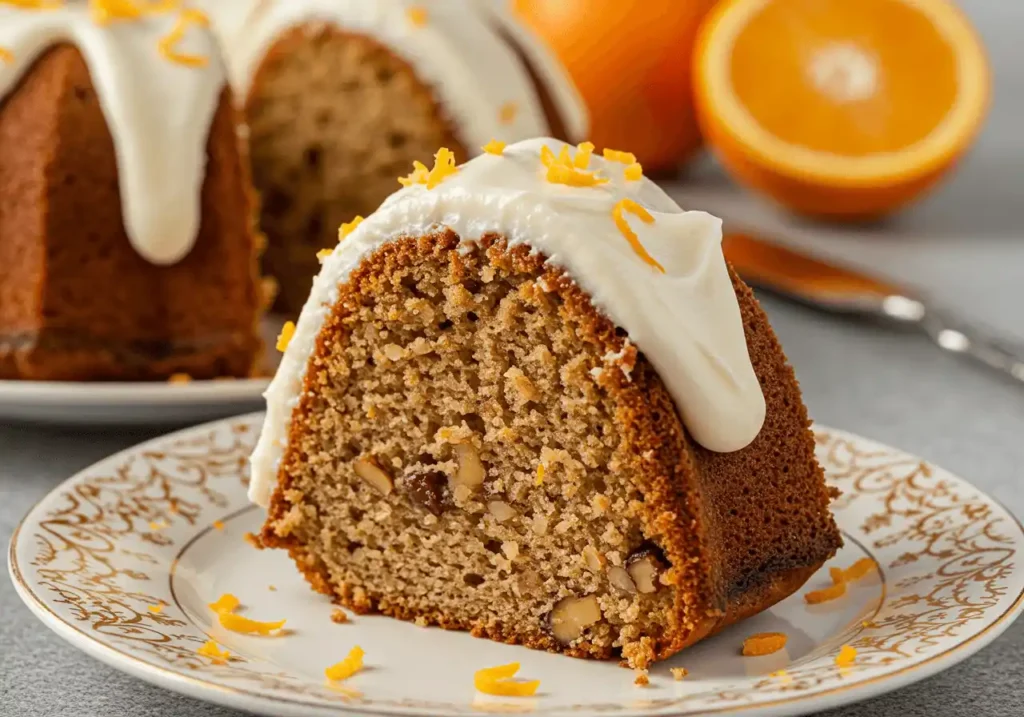
No matter how you serve it, the ring shape makes a striking centerpiece. Friends and family often gravitate straight to the dessert, drawn in by the aroma and unique design. It turns a routine spread into a memorable feast.
Conclusion
A bundt cake combines eye-catching form with timeless flavor. From its distinctive ring design to its soft crumb, it checks all the boxes for a dessert that stands out on any table. Many bakers appreciate the gentle crunch on the outside that develops alongside the tender interior. A few basic ingredients like sour cream, vanilla extract, and baking powder give it that reliable texture, while the shape itself turns the cake into an instant centerpiece.
The simplicity of a bundt cake also means you can decorate with minimal fuss. A quick drizzle of glaze or a sprinkle of powdered sugar is all you need, although a cream cheese topping can take it further. The process is straightforward, yet the result feels special enough for both casual get-togethers and more formal occasions.
Learning the main steps—proper greasing, mixing, baking, and cooling—helps ensure success. Even if you use a regular cake mix, it remains a practical choice that yields a showstopper dessert. With every slice, you capture the rich flavors of old-fashioned baking in a modern, approachable format. Whether it’s your first bundt cake or your fiftieth, the satisfaction of pulling a beautiful ring from the oven never fades.
FAQs
What sets a Bundt cake apart from a standard cake?
A Bundt cake is baked in a circular pan with a hole in the center. This design allows heat to circulate more evenly, creating a distinct ring shape and a golden exterior. The texture often turns out slightly denser than other cakes, thanks in part to recipes that use ingredients such as sour cream or heavy whipping cream. As a result, Bundt cakes frequently feature a soft crumb inside paired with a gently crisp crust on the outside, making them stand out from standard layer cakes.
What is the secret to moist Bundt cake?
The key factors include room temperature ingredients, proper mixing, and a source of richness like sour cream. Ensuring butter, eggs, and other dairy components have warmed up eliminates clumps and promotes a smooth batter. Adding a little extra moisture—through sour cream or even cream cheese—keeps the interior soft. Finally, watch your baking time. Using a toothpick test helps you detect the perfect moment to pull the cake from the oven before it dries out.
Is it possible to bake a standard cake mix in a Bundt pan?
Yes. Many people choose to use a regular cake mix for convenience. The main thing to watch is the baking time. A Bundt pan’s unique shape can alter how heat reaches the center of the cake. Keep an eye on the clock, and start checking for doneness about five minutes earlier than the package suggests. Your cake should feel springy, and a toothpick in the thickest part of the cake should come out with moist crumbs or clean when it’s ready.

